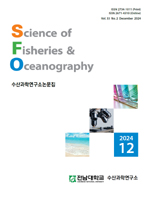Metabarcoding Analysis Reveals Diverse Prey Species in the Diet of Neophocaena asiaeorientalis sunameri in Korean Waters: Identification of Key Food Sources and Foraging Preferences
- 전남대학교 수산과학연구소
- 수산과학연구소 논문집
- 제33권 제2호
-
2024.12111 - 123 (13 pages)
-
DOI : 10.22714/SFO.2024.33.2.6
- 23

Understanding the feeding ecology of vulnerable species like Neophocaena asiaeorientalis sunameri (N. a. sunameri) is crucial for effective conservation. This study investigated the gastrointestinal microbiome and dietary preference of N. a. sunameri. Analysis revealed a distinct microbiome compostion and diversity in foregut, midgut and hindgut, with higher diversity in the foregut and midgut compared to the hindgut. A diverse range of prey species was identified, including fish (Pempheris cf.), marine bryozoans (Steginoporella truncata), planktonic tunicates (Oikopleura spp.), amoeba (Acanthamoeba spp.), copepods (Oithona atlantica, Parvocalanus crassirostris), diatoms (Thalassiosira sp., Skeletonema pseudocostatum), and the parasitic flatworm (Clonorchis sinensis). Strong correlations between 16S and 18S sequences were observed for several organisms, suggesting ecological relationships within the gut microbiome. Network analysis identified potential predator-prey interactions, symbiotic relationships, and parasite-host associations. These results provide valuable insights into the dietary ecology of N. a. sunameri and highlight the importance of considering regional variations within the gut when studying marine mammal diet and microbiome dynamics. Further research is needed to clarify the ecological significance of the observed correlations and the potential impact of Clonorchis sinensis on the host and the ecosystem.
Introduction
Materials and Methods
Results
Discussion
Conclusion
Acknowledgments
References
(0)
(0)